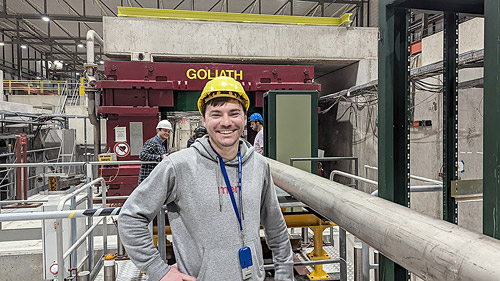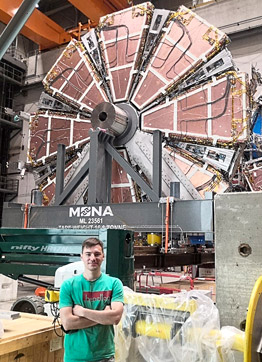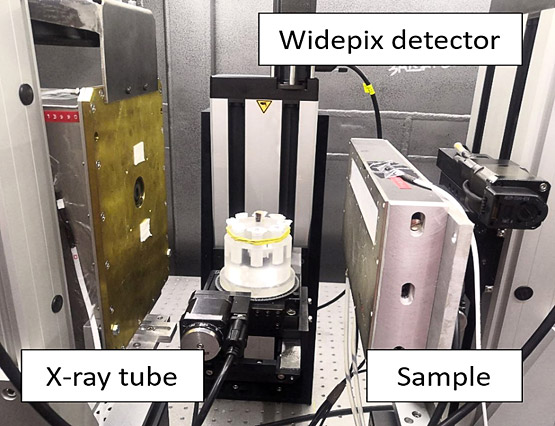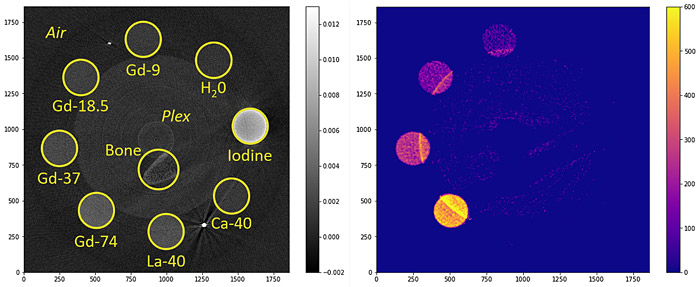
Electronic english version since 2022 |
The newspaper was founded in November 1957
| |
Personal dimension
Harmonious combination of interests
"It is important for me to see the results of my scientific work, to understand its application in areas useful for people," a junior researcher at DCB DLNP Rostislav SOTENSKY says. He has been working at the Institute for eight years now and does not regret the timely choice he made. In our newspaper, Rostislav tells about his fate and what he is engaged in at the Laboratory.

Questions about what I would become after graduating from university rarely visited my head and I only thought about it seriously in my fourth year. Then, at NRNU MEPhI, we began to have various departmental subjects and practical work in research institutes. The realization of what I wanted came gradually. Closed cities or numerous research institutes in Moscow did not warm my soul, I did not see any prospects for myself there. But at the same time, I wanted to do something related to nuclear physics. It was not for nothing that I entered a specialized university, where I studied for almost six years. Therefore, I did not want to go into other areas - IT, banks and so on.
I first heard about JINR in my junior years, having received scattered information. I had the mistaken impression that among dense forests and impassable swamps, there was a semi-closed or even secret town of Dubna, whose population worked at the Institute of Nuclear Research. Already in my senior years, a casual friend that had done an internship at JINR told me in more detail about the Institute and that JINR is not only fundamental science, accelerator physics and the synthesis of new elements. It has many other interesting areas, projects and of course, there is a place for people that want to work on applied problems.
Without thinking twice, I went to a reconnaissance interview. A couple of months later, having quit my previous job, I packed my belongings and went to Dubna. That is how my life at the Joint Institute for Nuclear Research started.
 |
| New small stator of the ATLAS muon system with Micromegas chambers (CERN) |
After completing the ATLAS Micromegas project, I didn't have time to be bored and idle, I was invited to try myself in another project. So, from 2021 to the present, I have been working in a group headed by Georgy Shelkov. The scientific interests of our group are quite extensive. This is the development and investigation of hybrid pixel semiconductor detectors, development of an energy-sensitive computed tomograph (ECT) based on these detectors that also includes reconstruction, visualization and analysis of tomographic data and more recently, participation in the development of an energy-sensitive pixel detector.
My main activity is dedicated to the development of new techniques and algorithms for identification, classification and quantitative analysis of substances of the studied sample for ECT. This work also concerns the research and development of techniques for improving the quality of the obtained tomographic data, including the adjustment of the tomograph, calibration of the detector, improvement of the scanning procedure, post- and pre-processing of data for reconstruction. In essence, it means that it is necessary to obtain "good" data, process them to improve the quality, taking into account the characteristics of the detector and tomograph, then recognize the substances that make up the studied object and determine how they are distributed inside the object.

Basic components of the experimental tomograph
Recognition of substances is based on spectral information, the acquisition of which became possible with the advent of new pixel energy-sensitive detectors. Such energy sensitivity in X-ray tomography allows determining the elemental composition of the sample under study based on the dependence of the X-ray attenuation curve of the substance in question. This approach is more universal and accurate than the traditional separation of substances based on the difference in the overall attenuation of X-ray radiation using different substances. Research carried out in this area will help in medical diagnostics and investigation of biochemical processes, will contribute to the development of search techniques used in geology and oil production and can also be used for archeological tasks.
There are several approaches to substance identification that depend on the specific task. One of these techniques was developed by us for recognizing contrast agents in an object in joint medical and biological research with colleagues from Moscow State University within the framework of the grant of the Russian Science Foundation No.22-15-00072. This technique is applicable for identifying elements with a high atomic number, having a K-edge of absorption (a sharp change in the attenuation of X-ray radiation) in the energy range from 25 to 100 KeV. A technique for recognizing light substances that do not have "anomalies" in the spectrum, such as water, biological tissues, hydrocarbon mixtures, is also currently developed but so far, it is very limited in application. To build a more universal identification technique or to improve current techniques, it is necessary to meet several other issues.
The first task is to transform or to approximate the experimental data that we obtain from the detector to the theoretical dependence of the attenuation coefficient. The scale of the experimental dependence is actually expressed, as they say, in "parrots" and we cannot directly calculate the attenuation coefficient. In the course of the work, it turned out that the task of transforming one into another is quite an issue. It is necessary to take into account a huge number of factors that also depend on many other parameters. At the moment, there is a dream to get closer to a solution but so far, there are only ideas that require verification and understanding.

Tomographic section of the phantom with different solutions (left). Results of the algorithm for recognizing objects containing Gd solutions and determining their concentrations (right). The algorithm was applied to each voxel, the color scale indicates the calculated concentration of Gd
The second task is to improve the quality of the data obtained. The image above shows inhomogeneities, rings, stripes and pixels in which the target substance is incorrectly recognized. These are mostly so-called reconstruction artifacts that negatively affect the result. They occur for many reasons and depend on the homogeneity of the pixel response, the quality of the tomograph alignment and calibration, the scanning procedure, the reconstruction technique and the processing of data before and after reconstruction. Therefore, it is necessary to select and improve the techniques for accumulating and processing tomographic data based on the characteristics of all components of our tomograph. We meet this extensive task with the efforts of our group together with interested colleagues from other organizations.
Now, I can say with confidence that I am completely satisfied with the subject of my work. One of the main reasons why I like my work is its versatility. It includes physics, mathematics, programming, a bit of electronics and all of this is supplemented by engineering and design tasks. In total, it turns out to be a diverse, interesting and creative job, with a minimum of the routine that I hate. In addition, it is completely clear why all this is done, it is known where and how it can be applied and used. I hope that I will be able to make a tangible contribution to this project. My personal goals for the near future are to work hard, to write and to defend a PhD thesis.